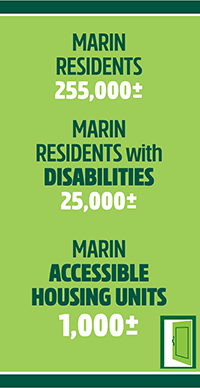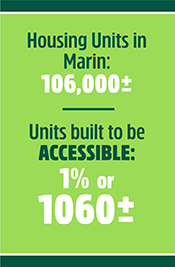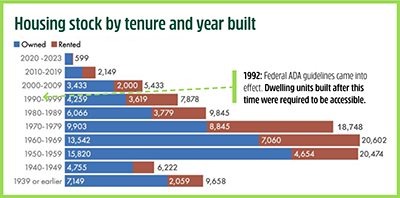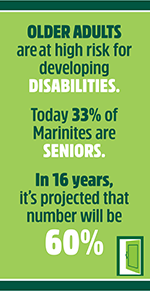Housing needs to be more accessible
| Housing needs to be more accessible. Our communities deserve it. – Carmela Davis, Housing Specialist, MEHC |
The housing crisis is dire for everyone, but especially so for people with a disability
Disability is the largest and most intersectional minority in the world.
Did you know that an estimated 10% of Marin residents have a disability? And that number is growing rapidly. People with disabilities are not limited to a specific age group or background – I am 24 years old and have been living with a disability that impacts my mobility since I was a student at Tamalpais High School. Disability is the largest and most intersectional minority in the world. Yet very little of our housing is built to be accessible.
One of the best ways to support people with disabilities in Marin is to encourage the development of new housing with disabilities in mind. Marin County abides by the Americans with Disabilities Act (ADA – the US federal accessible building code); nonetheless, we still lack accessible housing. That is unacceptable.
The housing crisis is dire for everyone, with a staggering lack of available units below market-rate. This number diminishes even further if you are looking for accessible affordable housing.

Less than 1% off all housing in Marin is accessible

The bulk of Marin’s housing was built from 1942 to 1979, long before California’s accessibility standards were first adopted in the 1980s and the ADA regulations became effective nationally in 1992. Only 1.2% of current housing stock in Marin was built during this century, and because most of the housing is single family homes – which are exempt from ADA standards – this means that today, less than 1% of all housing in Marin is accessible. To make things worse, Marin has the lowest housing production rate in the greater Bay Area.
Despite progress in accessible building codes, they don’t apply to the vast majority of existing housing

Although California’s accessible building codes are more progressive than the national ADA, Marin remains inaccessible to many. ADA and state regulations cannot always be applied to already existing structures, and new housing is not built fast enough for there to be a significant number of new fully accessible homes. Also, Accessory Dwelling Units (ADUs) and Junior Accessory Dwelling Units (JADUs) are not required to be fully compliant with ADA and California standards. So even though ADUs are widely accepted in Marin as a viable pathway to build more affordable housing, people with disabilities are still excluded.
Accessible housing is an urgent need, and Marin can only become more accessible by building more multifamily housing which complies with federal and local codes.
Disability is the one minority that any person, regardless of age, sex, race, socio-economic status, national origin can join at any time. This is particularly true in Marin, given our aging population. Older adults are at high risk for developing disabilities, and they make up 33% of our population; it is projected that by 2041 over 60% of Marin residents will be older adults, 65 and up. If we want to have a thriving, safe, and accessible future for current residents, ADA-compliant multifamily housing must be built now. As a MEHC staff member, I have heard first-hand accounts: aging in place is difficult due to the tasks required to maintain a single family home. If you have a disability that interferes with daily life, living in an apartment or town-home where you are not responsible for taking care of an entire property will confine your burden of responsibility to just your living space.

Planning for and building-in accessibility does not have to cost more
We implore everyone to encourage developers, elected officials, and other policymakers to build with accessibility in mind from the very beginning of housing projects, and publicly support these projects. It is a common misconception that developing accessible buildings is too costly – designing accessible spaces from the start of the planning process results in lower costs and better functionality than if done after the fact. Simple design modifications like wider doors for wheelchairs or walkers and accessible handrails can improve accessibility, safety, and quality of life for everyone, not just people with disabilities. And we shouldn’t forget that even minor design changes for housing intended for the able-bodied might make a real difference for residents’ visiting guests – particularly for a guest bathroom. The issue of a lack of accessibility in housing is deeply personal for many Marinites.
Four million people nationally cannot afford rent in any US market
According to the National Institutes of Health, people with disabilities are the most underemployed and underpaid group in the United States— making the Marin housing crisis especially challenging for this group. Despite some receiving monthly payments from Social Security Disability Insurance (SSI), more than four million people with disabilities cannot afford rent in any U.S. housing market. Rents for studio apartments in Marin start at $1,700 with no guarantee they will be accessible. And of the few affordable and accessible units in the county, some may be occupied by persons who do not have a disability and do not need disability accommodations. So there’s no guarantee that the small amount of accessible housing stock in Marin is actually benefiting someone who needs it.
It is time to change this trend and build more accessible multifamily housing – we deserve it… and we have a right to it.
| R E S O U R C E S |
| Disability Rights California Disability Rights Education and Defense Fund (DREDF) Fair Housing Advocates of Northern California (FHANC) Get Involved with Rooted in Marin Habitat for Humanity Grant program for retrofitting ramps for low-income homeowners. “Handicap remodel assistance” aging-in-place program Marin Center for Independent Living Vivalon |

You can be a part of MEHC’s important work by reading & sharing our monthly PERSPECTIVE newsletters, joining our weekly COMING UP IN HOUSING email list (signup here>>), participating in our advocacy campaigns, and also, if you can, by donating >> to help defray our expenses. Thank you.

